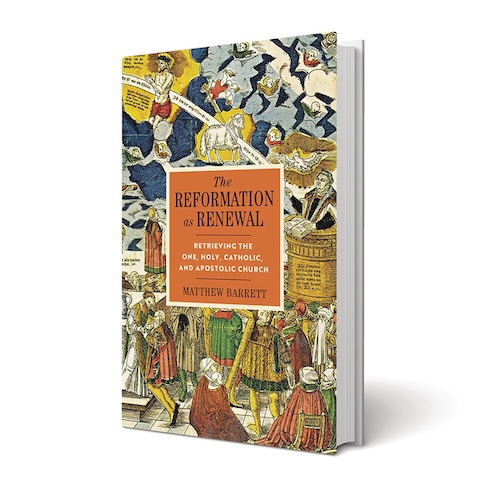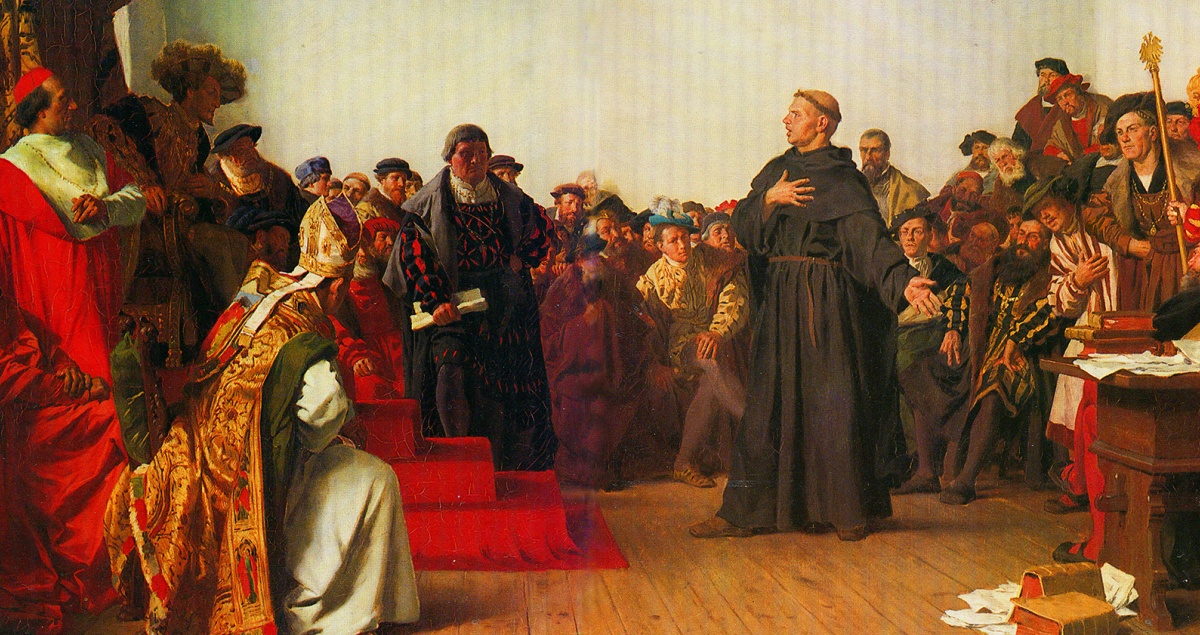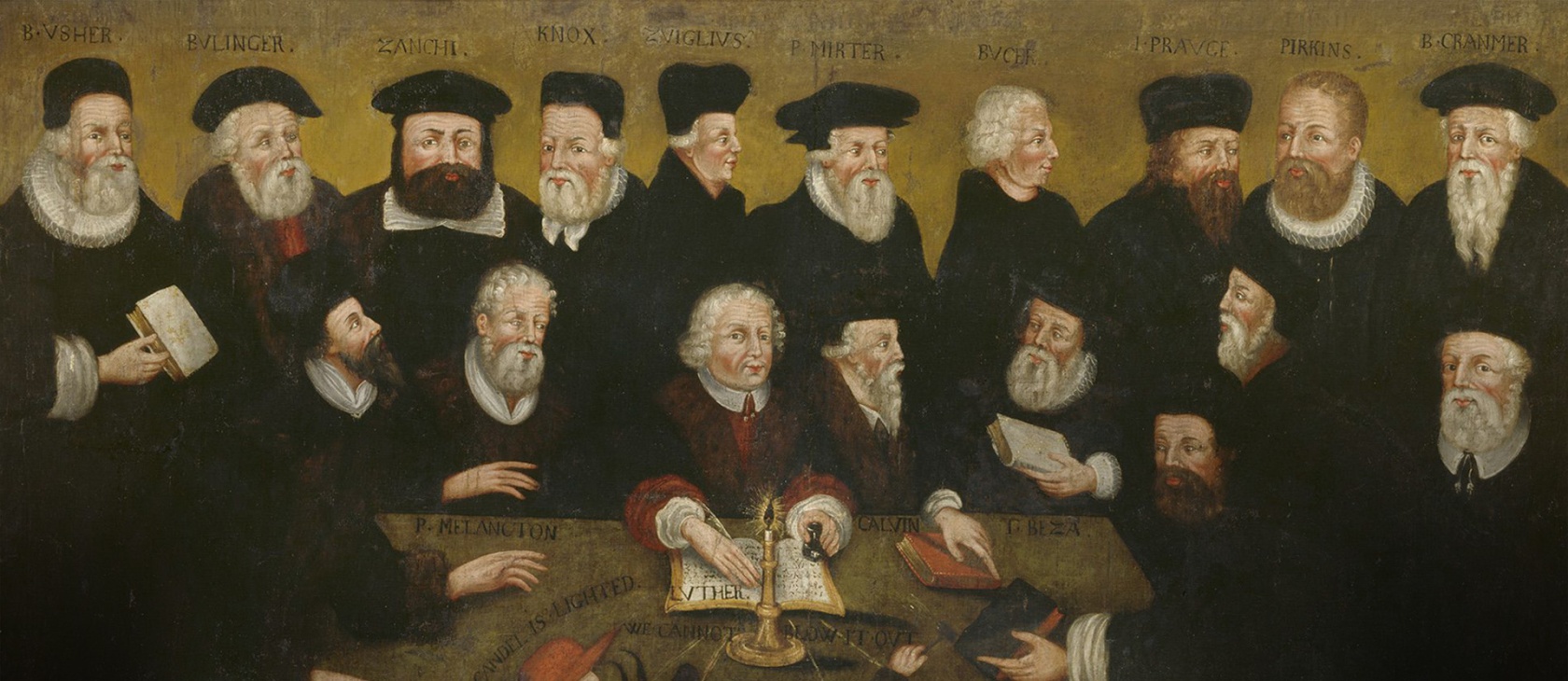Innocent visitors to an Episcopalian or Anglican church are often startled when the congregation blithely proclaim in the creed that they believe in “the holy Catholic Church.” Aren’t they supposed to be the other guys? But there are excellent reasons for that claim, and Matthew Barrett’s new backbreaking book, The Reformation as Renewal: Retrieving the One, Holy, Catholic, and Apostolic Church, is written to explain it. It is a claim that goes right to the heart of what the Protestant Reformation was and is.
The Reformers of the 16th century may have seen themselves as returning to an earlier “catholic” church, but the variety of communions their movement unleashed makes any plea for catholicity difficult to defend.

By Matthew Barrett
(Zondervan Academic, 2023)
Since ancient times, the Christian church has claimed to be catholic, or “universal”: the body of Christ, united across time and space, the living and the dead. It was one way the ancients distinguished orthodoxy from heresy. The true, catholic faith, Vincent of Lérins famously claimed in the fifth century, is that which has been believed everywhere, at all times, by all Christian people. By contrast, a heresy or sect is new, confined to a particular place, and led by a particular troublemaker. Heresies flare up and die out like candles. The Church shines as constant as the sun.
But, of course, it’s not so simple. Sometimes the “catholic” church, or some of its members, come up with a new formula—defining the Trinity, or the pope’s authority, or the nature of salvation. The claim is that this is not an innovation, just a clarification of long-standing beliefs; but not everyone agrees. Often enough, this sort of thing has led to splits that are not confined to one corner of Christendom but divide the entire body for centuries. Like it or not, the plain truth is that Christianity is a very, very plural tradition. There is in fact very little that has truly been believed everywhere, at all times, and by all Christians.
The term catholic—which began as a way of dismissing isolated dissidents—therefore became disputed property. The 16th-century Reformation was a particularly nasty divorce, and like so many divorces it was further poisoned by squabbles over who got to keep what. So, for example, both sides claimed to be evangelical, that is, to preach the true Christian gospel; but that word ended up de facto as Protestant property. Likewise, both sides claimed to be catholic, to represent universal, ancient Christianity. But nowadays, everyone knows who the word “Catholic” refers to. Maybe that division of the linguistic assets isn’t fair, but what divorce settlement ever is?
The book’s most urgent message to the evangelical community is: don’t think of yourselves as radicals or innovators.
So Barrett has an uphill battle to fight. He’s a professor at Midwestern Baptist Theological Seminary in Kansas City, and his main audience is his fellow Protestants: he wants them to remember and embrace their tradition’s catholic identity. In this he is plainly, inescapably, and importantly right. The Protestant Reformers really did understand themselves as catholic Christians whose hope was to return the whole church to certain ancient, universal truths from which they believed it had wandered. When the Augsburg reformer Urbanus Rhegius wrote a book called The New Doctrine in 1526, his argument was that the pope was teaching new (and therefore false) doctrine, while he, along with Martin Luther and others, had recovered older truths.
Ancient precedents were not all that mattered. The first Reformers were late medieval Christians, people of their own time. They had some sharp disagreements with the theological consensus of their age, but they were also immersed in that consensus and shared most of it. Barrett reminds us of a truth so obvious it is often forgotten: that Protestants and (Roman) Catholics agreed on all the great, central, historic doctrines of Christianity. Like modern political parties, the 16th century’s warring theologians were so focused on the issues dividing them that they forgot how much bedrock they shared.
It is a profound point. If this book is a little longer than it needs to be, if it could do with the attention of a good copy editor, and if it makes gratuitous use of words like homochromous, truths like this cover over a multitude of such sins. Indeed, the most theologically technical part of the book is the most important. This is where Barrett argues closely that the Protestant Reformers were heirs to much of the medieval tradition as well as to the early Church. “Reformers like Luther, Melanchthon and Calvin were more indebted (and possibly influenced) by Thomas [Aquinas] than they ever knew.” The book’s most urgent message to the evangelical community is: don’t think of yourselves as radicals or innovators, but as the inheritors of a long tradition. The Reformers were in the fullest sense conservatives.
In particular, Barrett is very concerned to rebut one specific charge: that the Reformers favored “univocity of being,” that is, that they believed created things (such as humans) exist in the same sense that God exists. Instead, he links them back to the older orthodoxy that our being is dependent and contingent; that we only exist because and to the extent that we participate in the eternal, absolute being of God. His argument here seems pretty sound to me. I am less clear that, as he hopes, it means the Reformers can be cleared of any blame for secularization.
So, yes: the Reformers really did see themselves as catholic Christians, whose aim was to renew the one, universal church, not to found a kaleidoscope of new ones. The harder part is that Barrett believes them. Although he claims endearingly that his book is not a defense of the Reformers’ views, he is soon enough referring to an argument against them as “another of the devil’s tactics” and claiming, less endearingly, that an idea he dislikes “deserves a slow and painful death.”

And yet … if we define the Reformers’ mission as renewing and repristinating the one, holy, catholic, and apostolic Church, we have to squint pretty hard to see it as anything other than a failure. They did not want to form new churches; Luther, at least, did not choose to leave the pope’s church but was expelled from it. But founding new churches, isolated to specific territories, is exactly what he and others ended up doing. The “catholic” church is supposed, among other things, to be worldwide, embracing all Christendom. During the 16th century, and indeed for a good two centuries to follow, Protestantism mostly remained a series of geographically confined, mutually suspicious sects. It’s no accident that the pope’s church, which kept the allegiance of the majority of Europe and was establishing missions all around the world, managed to hold onto the C-word for itself.
The Protestants stoutly replied that being catholic was not about institutional continuity or geographical extent (neither of which they could claim), but about doctrine and practice. They were, they insisted, the custodians of ancient truths that the papacy had abandoned. As Ronald Reagan said about the Democrats: he didn’t leave them; they left him. It’s a good line. But really? The razor-sharp English satirists W.C. Sellar and R.J. Yeatman defined the Reformation as when “the Pope … seceded with all his followers from the Church of England.” If you try hard enough, you can see the world that way, but you’re not going to bring many people with you.
Barrett’s argument is learned, exhaustive, and well-grounded, but for me it stumbles on two different, almost opposite obstacles. One is that the actual Reformation—the one that really happened, not the one the theologians imagined or the one its modern partisans might wish had taken place—was not nearly as catholic or as conservative as he suggests. It’s true that when Luther took his stand on conscience and the Word of God at the Diet of Worms he was not at all intending to create relativism, individualism, or the modern world. But maybe he did it anyway.
As Barrett’s narrative makes clear—he can’t avoid the fact—the Reformers were from the very beginning unable to keep their own supposedly catholic movement together. They called for a proper, free general council of the Church to resolve their theological concerns, but the truth was—a truth Luther had conceded as early as 1519—that no such council could ever work, because those who disagreed with it would refuse to be bound by it. They would appeal to Word and conscience instead. The Reformers wanted to renew catholic orthodoxy, but they couldn’t do it, because they couldn’t—and still can’t—agree on what that orthodoxy should be. That is not an accident or some unfortunate outcome of the Reformation. It was baked in from the start.
To make his argument work, Barrett has to exclude the radicals, spiritualists, and Anabaptists from the group he calls “the Reformers.” It is true that these people generally did not claim the “catholic” mantle for themselves, although Barrett has to be nimble in arguing that his own Baptist tradition should not be tarred with the same brush. Unfortunately, the cordon sanitaire between respectable catholic Reformers and dangerous Anabaptist radicals is a lot more permeable than Barrett admits. For a couple of decades now, scholars have been pointing out how many people resist easy classification as one or the other, or indeed crisscross the line. The “mainstream” Reformers badly insisted that the radicals were quite different from themselves and were willing to persecute them brutally to underline the point. But the Reformation generated radicalism around itself wherever it went, like saplings around a tree. You can chop them down, but they will keep springing up, and you can’t claim that that is a coincidence. Leave them alone and they may outgrow the original.
The actual Reformation was a cacophonous explosion of religious variety, which did not in fact create anything that looks particularly “catholic.” It is true that the sapling we call the Baptist tradition is rooted, at least partly, in Calvinism, but in a strand of Calvinism that, during the ferment of England’s civil wars, decided to abandon the aspiration to be a single, catholic church and instead to embrace voluntarism and the status of a minority sect.
The Reformers were from the very beginning unable to keep their own supposedly catholic movement together.
The other problem is almost opposite: the R-word itself. Barrett talks unselfconsciously about “the Reformers” and “the Reformation,” but while Luther and his contemporaries certainly believed they were engaged in reformation, the idea ofthe Reformation, a singular event not an ongoing process, was not one they would have recognized. Barrett says, for example, that “Erasmus was no Reformer … the Reformation had not yet begun when Erasmus’ edition [of the New Testament] was published.” But Erasmus of Rotterdam was nothing if not a reformer. What Barrett means is that he did not anticipate Luther’s theology of salvation, which is true—but that capital R in his sentence is doing an awful lot of work. The label “the Reformation” only began to be applied to the events Luther triggered from the late 1600s. If we’re going to use it, we need to be aware that it’s an anachronism.
On its face, this would only strengthen Barrett’s argument. The particular group of reformers he calls “the Reformers” were not, in their own eyes, a species apart: simply members of the one, holy, catholic, and apostolic church intent on reforming it from within, like so many others before and after them. The process of reformation is a continuous fact of the church’s earthly existence. The idea that there should be one, singular reformation, the Reformation, is almost offensive. If we apply that label to the 16th-century movement that (despite itself) resulted in schism and in the emergence of Protestant churches, we are in effect denying their movement the very catholicity on which Barrett wants to insist. But if we do not—if this simply becomes one movement for reform in the long sweep of Christian history—then its leaders are no longer heroes, its theology is no longer normative, and the sand shifts under Protestantism’s feet.
It’s a cruel dilemma. You can have Catholicity, the whole rich, varied, squabbling, ugly, beautiful tradition. Or you can have the Reformation, a single, bright heroic moment. I’m not sure you can have both.



